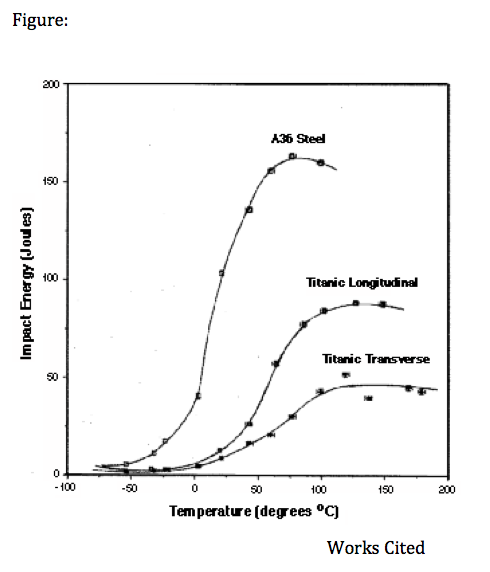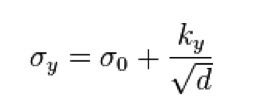|
|
The hull of the Titanic was made out steel with high concentrations of phosphorus and sulfur that altered the mechanical properties for the worse. The Titanic used steel that was created in an acid-lined open-hearth furnace, which accounts for higher than usual quantities of phosphorus and sulfur (Jankovic). High amounts of phosphorus affect the mechanical performance of the steel by reducing plasticity and strength, especially at low temperature (Iron-Foundry). Small amounts of sulfur are added to strengthen the steel, but in the case of the Titanic they used an unusually high percentage of the element (Alloys, 2011). On Sunday 14th April 1912, the Titanic embarked on its maiden voyage in -2 degrees Celsius water, substantially lowering the steel's fracture point (Jankovic). The figure below (Jankovic) compares the failure modes of the Titanic's hull to that of ASTM A36 Modern Steel. When set within a scenario of -2 degrees Celsius C water, the Titanic's steel enters its failure mode at a very low impact force. Whereas with A36 steel, the failure mode can withstand roughly five times the impact force. Due to the low temperature of the water, and the high amounts of phosphorus and sulfur the Titanic's hull became very brittle on its voyage.
Modern structural steel contains a greater quantity of manganese than the steel that was used in the Titanic; this is because the quantity of manganese has a direct affect on the steels ability to remain ductile in cold temperatures rather then becoming brittle. A low manganese content in steel can lead to a more brittle alloy because the sulfur does not have any manganese to bond with, however, this is not the case in the Titanic's haul (Foecke). It would appear from Foecke's experiments that there was a sufficient quantity of MnS particles (Foecke). Foecke argues that Manganese has the additional property of being able to toughen solid-solutions, which can be seen by studying the shifting the transition temperature of the steel (Foecke). Jankovic found that in the Titanic's case the low amount of Manganese effected the steel by moving that transition point to approximately 33 degrees Celsius for the longitudinal specimens and 56 degrees Celsius for the transverse specimens which meant the Titanic's steel alloy was not capable of operating in the temperatures it was subjected to (Jankovic). As seen in Jankovic's figure below (Jankovic), this meant that the Titanic could absorb less then half of the impact energy that modern structural steel can at the temperature that it was being used in and its inability to absorb that energy meant that it fractured when it struck the iceberg in icy water on the night of April 14th 1912.
The effect of grain size on the mechanical performance of steel is that as the size of the grain increases, the strength of the steel decreases. The stress on the metal is higher as the number of dislocations increases. When the grain size is larger the critical stress required to dislocate particles increases more quickly than with smaller particles. With larger grains, these dislocations are forced to pile up at grain boundaries which is "...detrimental in the brittle range, because of the intensity of stress where dislocation pile up ..." (McEvily) resulting in fracture.
Smaller grains stop grain dislocation at the grain boundary making smaller grains stronger than larger, as larger grains can be dislocated much further without being stopped by a grain boundary (Gedeon). With small grains, the atoms are able to move more freely across one another, creating slip planes, which absorb impact more readily. If the applied stress is in line with a slip plane, then the atoms move readily without dislocation. With many grains orientated in many different directions, the "...microscopic directionality of strength would tend to be averaged out..."(Gedeon), which results in equal strength in all directions. This method of using smaller grain sizes to increase toughness and yield strength is called Hall Fetch strengthening.
The large ferrite grains and coarse pearlite meant that the Titanic had a higher transition temperature and lower upper shelf toughness, resulting in weaker hull strength in cold water at a high speed. The impact with the iceberg at 20 knots would have been a high strain impact. The sudden impact contributed to the brittleness of the steel as the toughness was decreased with the large grain size. Since the Titanic was sailing -2 degrees Celsius water, the steel was already very brittle before the impact occurred. The large grain size and pearlite used in the hot rolled steel of the Titanic differs from today?s modern steel, which contributes greatly to its failure when impacting with the iceberg.

Figure: http://www.tms.org/pubs/journals/JOM/9801/Felkins-9801.fig.7.lg.gif
Alloys, Chase. "Effects of Alloying Elements in Steel ." 2011. Chase Alloys. .
Iron-Foundry. "The effect of cast steel chemical composition C, Si, Mn, S, P, Cr, Mo, Ni to mechanical properties." Copy write DANDONG RUIDING FOUNDING CO., LTD. All Rights Reserved. .
Jankovic, A. "The Royal Mail Ship Titanic: Did a Metallurgical Failure Cause a Night to Remember?" The Member Journal of The Minerals, Metals, and Materials Society 50.1 (1998): 12?18. Web. 10 Jan. 2014.
Foecke, Time. Metallurgy of the RMS Titanic. 1998. National Institute of Standards and Technology.
Gedeon, M. (n.d.). Technical Tidbits. Technical Tidbits Issue 15. Retrieved September 26, 2014, from
http://materion.com/~/media/Files/PDFs/Alloy/Newsletters/Technical%20Tidbit s/Issue%20No%2015%20- %20Grain%20Size%20and%20Material%20Strength.pdf
McEvily, A. J. (2013). Metal failures mechanisms, analysis, prevention, second edition (2nd ed.). Hoboken, N.J.: John Wiley & Sons.
Hall- Petch Relation expresses yield strength.

sigma y - yield stress
sigma o - lattice friction
k y - constant (specific to material) d - average grain diameter.
(lattice friction is stress required to move a single crystal)
|